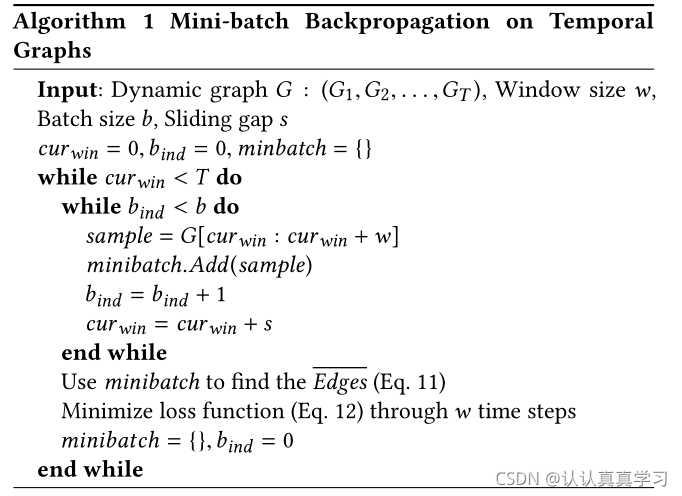摘要
学习图的拓扑结构外,还关注于学习时间信息。提出了一种动态图的无监督表示学习体系结构,旨在学习随时间演化的图的拓扑和时间特征。该方法由嵌入门控图神经网络(GGNNs)和长短时记忆网络(LSTM)的序列-序列编解码器模型组成。GGNN能够在每个时间步学习图的拓扑结构,而LSTM则用于在时间步之间传播时间信息。此外,编码器学习进化图的时间动态,解码器使用编码器提供的编码表示在相同的时间段重建动态。
相关工作
静态图
动态图
节点的表示学习。37-32-16-15-42-5-38
问题定义
动态图定义。初始节点表示由邻接矩阵表示。专注处理无向图的图嵌入。
序言和注释
GGNN,LSTM.Sequence-to-sequence.
动态图的递归模型
GGNN用于在每个时间步对图形拓扑进行建模,更具体地说是为编码器提供输入。编码器的循环结构允许我们使用时间步历史HG的隐藏表示和时间步t的图形拓扑嵌入Gt。

DyGGNN:该模型包括三个主要组件:1)一个GGNN,用于捕获时间步长t处的图形拓扑;2)一个编码器,用于将图形在时间步长窗口上的演化投影到ak维空间;3)一个解码器,用于使用隐藏表示在每个时间步长处重建动态图形的结构。图1显示了我们的动态图在时间步长上的表示学习方法的体系结构。
GGNN通过考虑Gt在时间步长t处的拓扑结构,为Gt构建一个图表示。
我们使用LSTM编码器将Gt投影到一个隐藏表示中,通过大小为w的观察窗口传递动态图形Hg的信息,并使用过去w个时间步的图形拓扑知识计算动态嵌入Gt。

将这个称为图的动态嵌入。解码器LSTM-dec的主要目标是在大小为w的观察窗口中重建图形HGT的历史。解码器作为一个自回归模型,在给定最近在前一时间步预测的图的情况下,在时间步t预测图的拓扑。解码器使用henc T初始化其第一个隐藏状态。图的边集是解码器在每个时间步的预测。


训练

O是时间窗口,大小为w。
注意时间窗口大小w的选择。动态图G,它是一个图快照序列,我们需要考虑节点隐藏状态的序列。我们不能独立地考虑节点的序列,因为我们需要考虑图的时间和拓扑结构。使用滑动观察窗,我们将动态图分解为多个动态图。将连续窗口组合在一起,形成一个小批量(算法1)。通过这种方式,我们不仅保留了每个窗口的时间依赖性,而且还捕获了顺序窗口之间的隐式关系,因为模型参数是在考虑整个小批量输入数据的情况下更新的。

数据集
基础方法
超参数
结果
动态性很重要,在嵌入方法中加入时间信息可以改进图形表示。
模型分析
图的动态表示的使得模型的精确性由于静态表示的。与静态表示相比,通过时间对模型进行训练可以显著提高动态嵌入的性能。
结论
我们提出了一种在动态环境下对整个图进行表示学习的有效方法。我们在一个真实的动物行为数据集中评估了我们的方法,结果表明,与在静态环境中学习图形表示的最先进模型相比,我们的模型取得了显著更好的性能。有前途的结果证实了我们的方法作为动态图形分析的坚实基础。























 8126
8126

 被折叠的 条评论
为什么被折叠?
被折叠的 条评论
为什么被折叠?








